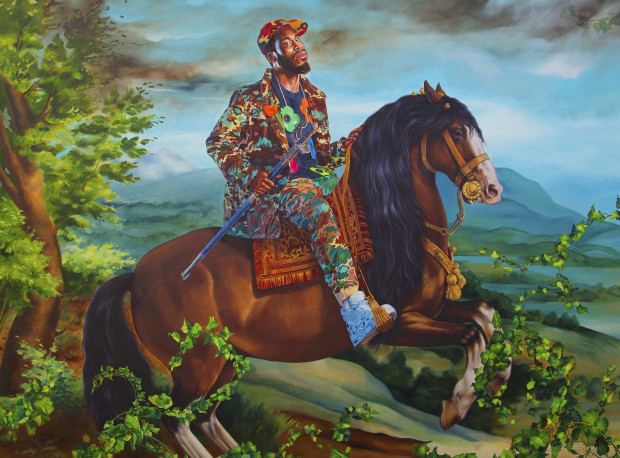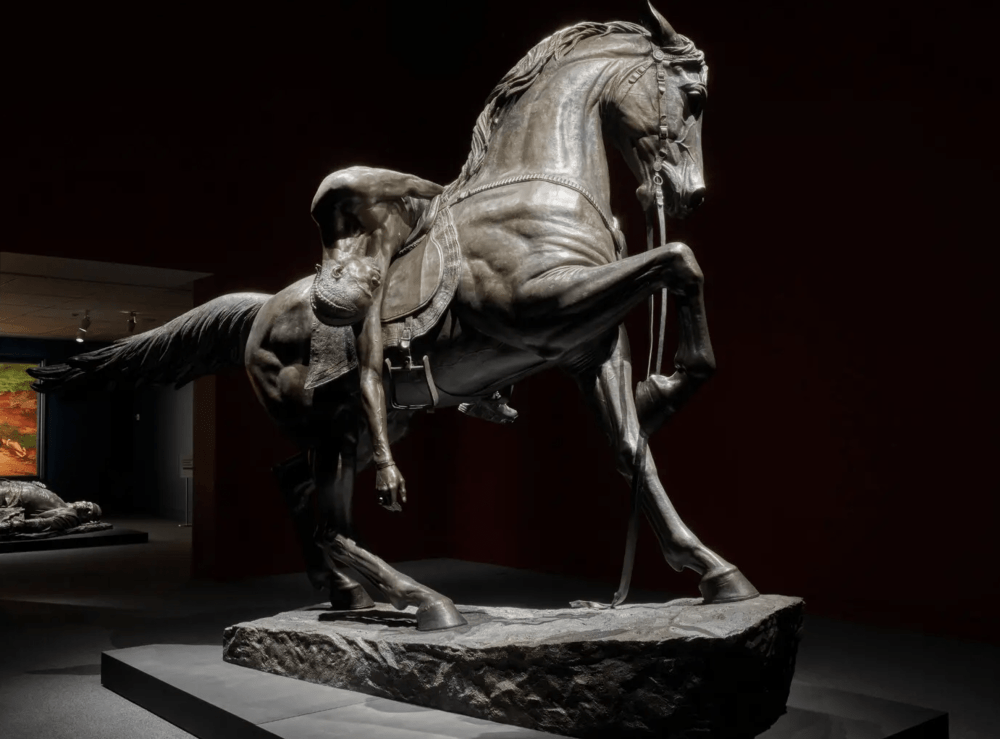

By Jori Finkel
To enter Kehinde Wiley’s show An Archaeology of Silence is to step into darkness, where only the art itself seems to emit light. The space feels somewhere between a crypt and a cathedral, featuring paintings and bronze sculptures of reclining Black bodies, spread out in repose or entombed like corpses, that appear to glow from within.
The show, now at the Museum of Fine Arts, Houston, culminates with a monumental sculpture of a fallen man on horseback, draped over the horse as if he had just been shot, his Nikes dangling below the saddle. Made in the year after George Floyd was killed by the police in Minneapolis, this monument—and more broadly, the show as a whole—confronts the “legacy and scope of anti-Black violence,” according to Darren Walker, president of the Ford Foundation.
While his particular blend of the contemporary and historical is all his own, Wiley is just one of several artists working these days to stage dramatically dark exhibitions. Across the country, visual artists are plunging visitors into museum spaces where you can hardly make out the wall labels in front of you, and not just for film and video.
In Southern California, Betye Saar has powerfully dimmed the lights for a new installation at the Huntington Library, Art Museum, and Botanical Gardens, “Drifting Toward Twilight,”which simulates the stages of nightfall. And for his show “Elegy,”which recently closed at the Virginia Museum of Fine Arts, Dawoud Bey created a moody, nearly funereal environment for his black-and-white landscape photographs, taken on or near sites associated with the Underground Railroad and the Richmond Slave Trail.
Other examples appear on the commercial gallery front, from Anselm Kiefer’s brooding paintings in “Exodus,” presented by Gagosian at the Marciano Art Foundation last year, to Tavares Strachan’s multipart racial excavation “Magnificent Darkness” at Marian Goodman this spring — both ambitious historical reckonings. Without going pitch black, which would create visitor accessibility and safety issues as well as obscure the artworks, these artists are finding ways to evoke darkness with a range of symbolic, psychological and spiritual overtones.
The most obvious implication of all these darkened exhibitions is that we are living in dark times, which is hard to refute. But artists and curators involved say it’s more nuanced than that, and these shows are not simply an expression of grief or mourning.
“What I wanted to do is create almost a kind of religious feeling,” Wiley wrote in the catalog for his “Archaeology” show. The lighting “compels you to encounter the works with a degree of devotion or reverence,” added Claudia Schmuckli, who curated a version of the exhibition at the de Young in San Francisco last year, following the works’ debut in Venice. (The American version will continue its tour after Houston to the Pérez Art Museum Miami and the Minneapolis Institute of Art.) “It inscribes the artwork in a context of sacredness.”
As for the impression that Wiley’s artworks are lit from within, Schmuckli said that was just an illusion. In actuality, fixtures known as “framing projectors” are used to focus the light within the perimeter of a particular canvas and avoid spillage or shadows. Given their brilliant colors and this precise lighting, the paintings achieve some of the luminosity of stained glass.
Saar, too, used spiritual terms in discussing her installation, which occupies its own blue-tinted room deep in the American art building at the Huntington and runs through Nov. 30, 2025. It features a 17-foot-long wooden canoe from the 1940s, painted emerald green and set on a bed of branches and twigs that the artist made by collecting a dozen different plant species from the Huntington grounds. The boat carries a bizarre group of passengers: two carved wooden creatures sporting tall antlers and three metal bird cages containing antlers.
While the canoe doesn’t actually move, it takes a journey through time as the room’s lighting cycles every eight minutes through different hues, approximating the sun rising and setting. Most striking is the moment when the canoe is bathed in a dusky blue-violet glow, like a portal to another realm.
“Twilight is the magical time, we know that,” said the artist, who is 97 and compared her artwork’s lighting cycle to a human life cycle. “That’s when nothing is definite, it’s always changing, that’s the way life is.”
Yinshi Lerman-Tan, who co-curated this installation for the Huntington, explained that there were 27 lights in this room, 20 of which were programmed to change, and four different colors creating a gradient on the walls, starting with a “Galapagos Turquoise” at the bottom. She compares entering the room to walking into a James Whistler or J.M.W. Turner painting that delivers “this atmospheric space between ocean and sky.”
Betye is harnessing the other world of the cosmos and the other world of the ocean or sea,” she continued. “Those have both been career-long interests in her work.”
“My job is to create a space where the spirit can be aware,” said Saar, who has long used lighting to transport her viewers into different realms. She said she first learned “how important theatrical lighting is in setting the mood” when designing costumes for the theater in the late 1960s.
For Bey, controlling a room’s lighting offers a way of creating “emotional weight,” he said. The first time he dramatically transformed a space in this way was in 2021 for his survey at the Whitney Museum of American Art, for both aesthetic and practical reasons, including a desire to play video alongside photography. “It was a revelation to me,” he said. “The whole thing looked good, and there was quietude in that space that resulted. It creates a more contemplative experience. It heightens the individual drama of the work and encourages you to linger longer.”
To achieve this effect, though, Bey typically does not have to adjust the museum lighting levels much at all. Rather, he has the walls painted a rich, inky black that absorbs light, a Benjamin Moore color called Black Panther. “Once the light is not bouncing around the room, you don’t have to fine-tune the lighting as much — it’s a lot easier for the lighting crew actually,” Bey said.
He did this most recently for part of his show “Elegy” at the Virginia Museum of Fine Arts, which culminated in the darkly toned, lushly printed gelatin-silver landscapes that make up “Night Coming Tenderly, Black,” the series that imaginatively follows the path of the Underground Railroad, set against Black Panther. Valerie Cassel Oliver, the curator of “Elegy,” said there was an unintended visual effect in that gallery — the white photographic borders were reflected on the museum floors — but even that seemed richly symbolic. The visual echo, she said, “played into the sense that there was this glowing light of freedom, of self-emancipation, after the enslaved came through the horrors of the trans-Atlantic slave trade into this laborious life under bondage on these plantations.”
The idea that an artist’s vision might extend beyond the picture frame to include lighting can be a challenge for the most traditional, or hierarchical, museums. “Museum spaces are usually the purview of the exhibition design team working with the curator, and the artist is seldom involved,” Bey said. “Generally speaking, they like everybody to stay in their own lane.”
But that much is changing, said Bey, who was also able to work with the Getty to darken walls for a joint show with Carrie Mae Weems in 2023 and who notes that museums have become “much more receptive to artists” in recent years. Cassel Oliver agreed: “We know that encyclopedic museums have been risk-averse, but they are evolving and becoming a wonderful platform for living artists as well.”
In effect, these museums are following in the footsteps of alternative institutions, which have a long history of ceding control to contemporary artists to remake a space, floor to ceiling. For instance, when the Colombia-based artist Delcy Morelos requested skylights be covered for the first room of her exhibition “El abrazo” at Dia Chelsea, running until July 20, it wasn’t a huge ask, she said. “Dia is a very special institution when it comes to supporting artists — they never put a limit on me creatively.”
Morelos also kept artificial light to a minimum, only to be used at the end of day in a space she covered with nutrient-rich soil. The soil coats the floors, stacks of lumber and part of the walls—up to the water-mark created by Hurricane Sandy in 2012. In this case, Morelos said darkness was a tool or “material” she used to sharpen visitors’ other senses, like smell, so they’re more receptive for example to the scents of the moist earth, cinnamon and cloves embedded in the work.
Explaining the decision, she said through a translator: “Senses that are dormant when you have a lot of light will awaken, perhaps because of the sense of danger.” She compared her space to a “symbolic but also real” dreamscape as well as to a womb, describing a “fertile obscurity.”
“Seeds need darkness to germinate,” she added. Or, as James Baldwin once wrote, “One discovers the light in darkness, that is what darkness is for; but everything in our lives depends on how we bear the light.”
This comment was published in a 1964 book that Baldwin made with the photographer Richard Avedon. It also appeared this year at the Marian Goodman Gallery in Los Angeles, spelled out in flickering neon by the artist Tavares Strachan and placed prominently at the entrance of a dimly lit gallery, where his paintings and sculptures look like beacons in the night.